 Creating a higher flat or vaulted ceiling adds a more spacious feeling to just about any room and is undoubtedly the reason why this type of ceiling has become more viable on the market. This design may look appealing; however, it can also make living a little more uncomfortable as it is harder to heat and cool the rooms where they are located.
Creating a higher flat or vaulted ceiling adds a more spacious feeling to just about any room and is undoubtedly the reason why this type of ceiling has become more viable on the market. This design may look appealing; however, it can also make living a little more uncomfortable as it is harder to heat and cool the rooms where they are located.
This problem can be avoided by keeping in mind these three factors: proper design, planning, and familiarization with building techniques. By doing this, it will be possible to have a good looking and better functioning vaulted ceiling.
Design plans should include larger windows or skylights to allow for natural light in the space as an energy-saving factor. For this article, a ceiling with a joist will be referenced as an example. Following are some of the factors that need to be considered.
Joist Removal
For houses built during World War II, a usual ceiling joist separated the attic space above and the rooms below, providing a maximum volume of open space through selective removal of some of the joists. In such cases, joists can be removed without undermining the structure’s integrity by properly fastening the remaining joists.
It is recommended to consult with a structural engineer before performing this action. By code, the horizontal ties installation should not exceed four feet on center. After completely removing the joist, new wood or a steel rod can be installed up from the roof, placed at about a third of the distance which will result in a more spacious feeling.
Proper Insulation
The process discussed above includes the removal of the old insulation between the ceiling joists and the roof’s surface. New insulation will be installed between wall studs, especially if the new space has a gable or side wall. For kraft-faced of eighty-inch thick R30 compressed batt, it will be sufficient to have a rafter of two by ten inches.
To provide sufficient venting, be sure to leave at least one and a half inches of airspace above. The air opening under the eaves and ridges at the top of the roof is important for ventilation through the rafter cavities. Providing proper air-flow passage prevents ice damming during winter time, the elimination of moisture, and the prevention of mold growth. Having vent space and new insulation, the project is ready for the finishing material. Gypsum board can be used and wood paneling or sheathing can be placed over it to make the home more air-tight.
Skylight Installation
Adding skylights between the roof rafters will not only increase natural lighting in the room but also add a sense of space. It is recommended that the skylights be placed facing north to get the best quality light. For those who live in hot climates, avoid placing them on west or south slopes of the roof as this will increase heat gain and glare. If more windows are desired, it is recommended not to exceed five percent of the floor space for the total skylight area; however, with fewer windows it can be fifteen percent of the total floor space.
Following the principles outlined above for vaulted ceilings will prevent any negative impacts on energy costs. Using these methods also prevents the roof from having problems due to leaks and air stratification. Learning how easily this can be done, it is now clear that the roof does not have to be raised to get a vaulted ceiling!
Call Schulte Roofing for All Your Roof Houston Needs!
Is a roof Houston company something you need to help create a high ceiling in your house? Call the knowledgeable professionals at Schulte Roofing at 800-367-7663 who can help all greater Houston area customers with this and any other roofing needs!
